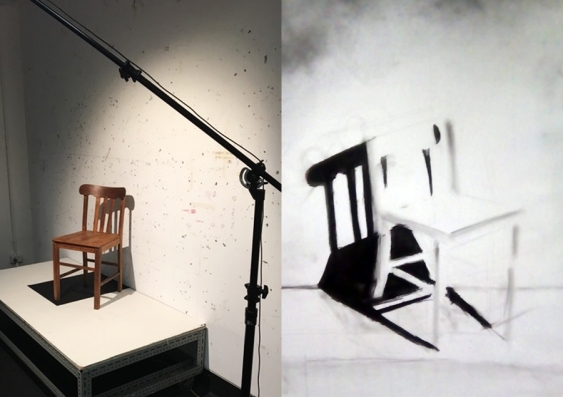Quantum physicists take an art class to rethink their view of reality
Ask a quantum physicist to draw a chair and the result can be a fundamental shift in how they see the world.
Ask a quantum physicist to draw a chair and the result can be a fundamental shift in how they see the world.

Diane Nazaroff
UNSW Media & Content
+61 (2) 9385 2481, +61 (0)424 479 199
diane.nazaroff@unsw.edu.au
Possibly the world’s first ever quantum drawing workshop has been held at UNSW.
Professor of Fine Art Paul Thomas invited 14 participants from UNSW’s ARC Centre of Excellence for Quantum Computation and Communication Technology (CQC2T) to examine Bell’s theorem (1964) via their still life drawing of a simple wooden chair.
Bell’s theorem draws an important distinction between quantum mechanics, a branch of physics that deals with the behaviour of sub-atomic particles, and the world as described by classical mechanics, or nature at an ordinary scale.
The theorem was designed to prove or disprove the fundamental concepts of quantum mechanics.
In the process of drawing a chair, Professor Thomas said, the physicists were presented new ideas about the role of the observer and the probabilities involved in trying to capture a reality.
“I have been interested in quantum physics since 2010, when I started at UNSW, so I developed artworks around what (CQC2T Program manager) Andrea Morello is researching in the Quantum Computing Centre,” Professor Thomas said.
“As I developed a fascination of physics, I became interested in the role of the observer in physics and how it changes the state of what is being measured. So, this change of state becomes analogous to the relationship between the role of the observer in physics and the role of the observer in drawing.
“I wanted to test this out and see how the physicist thought about the process of drawing, as opposed to the artist thinking about the process of the observer in science.”
Professor Thomas said through drawing, the physicists questioned their roles in observing and measuring.
“I’m trying to learn the language of physics to challenge the notion of fundamental concepts of seeing the world, because at the moment [physicists] have very focused ideas about how these things are progressing, whereas artists have historically been very involved in notions of perception,” he said.
'If all scientists are basing their observations through technologies, what would it be like if their perception were able to inquire from different perspectives?'
“I am just trying to encourage those same students to draw, hopefully to increase that perception, by making these relationships that are analogous relationships between what they do as physicists and what they do in the act of drawing.
“If all scientists are basing their observations through technologies, what would it be like if their perception were able to inquire from different perspectives? To be able to understand and comprehend things through the very act of seeing, then one would think that it’s a very important thing for them to do?”
He said throughout the activity, complex subjects such as entanglement, superposition, and the classical-quantum divide were explored in relation to the act of drawing.
CQC2T Program manager Professor Andrea Morello said the workshop was “a curious experiment in exposing professional quantum scientists to the aesthetic and practice of drawing”.
“Paul Thomas gave us some insightful analogies between the act of placing marks on the paper, and the act of observing, or 'projecting', a quantum system,” Professor Morello said.
Irene Fernandez, who is doing a PhD in Quantum Computing at the School of Electrical Engineering, said the workshop inspired two ideas.
“The idea that when you make a trace, you statistically determine the reality of the object that you are trying to measure,” she said.
“I could see the chair as the reality that [Albert] Einstein believed in, and my hand as the tool of quantum mechanics.”
“[Secondly] the idea that the material memory makes this interesting effect where you no longer control your drawing, but it is the drawing that starts driving your decisions.”
Ms Fernandez said she hoped there were more art-related activities like the drawing workshop in the future.
“Physics and arts should be more connected, because in the end, both are human expressions and just because of that, they should be more often related,” she said.
Professor Thomas said intentional repositioning and reshaping of science practices through art can promote exploration of different ways of visualising, perceiving, understanding, communicating and acting in the material world.
“In so doing, this workshop becomes a new model for facilitating transdisciplinary development of alternative domains and discourses that garner insights gained from visual communication, technological interaction and embodied practices.”
Professor Thomas plans to run further quantum drawing workshops in the future.
His book Quantum Art and Uncertainty will be released in mid October.